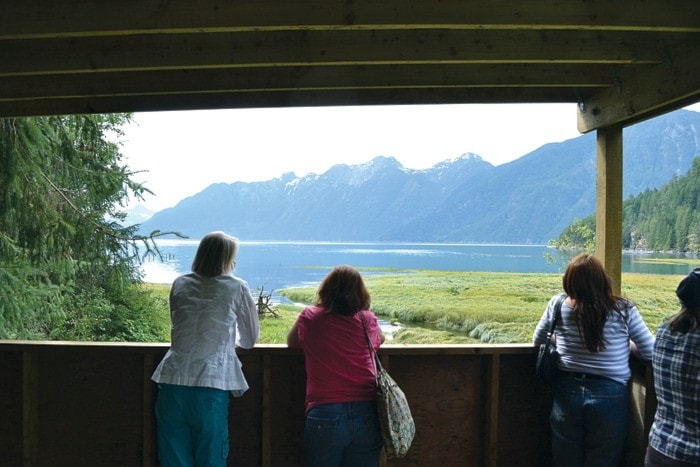The Orford River delta was quiet on Saturday except for the breezes sending waves through the long grasses lining the estuary.
In a few weeks, however, the grasses will be disturbed by the heavy footfall of 400 kg grizzly bears and that’s when the reason for a celebration held Saturday will become evident.
The Homalco First Nation transported 105 guests to commemorate the latest addition to the Homalco Wildlife Tours facility at Orford Bay, an orientation centre that will introduce visitors to the Homalco First Nation’s story from the pre-colonial period to the present.
“I just want to thank you for sharing and celebrating this special day for ourselves,” Chief Richard Harry told the visitors.
The Homalco Band’s story is one of a proud and powerful aboriginal nation suffering at the hands of European colonists through the loss of traditional territory. They then endured relocation to a permanent site, the loss of their children to residential schools and then, finally, in the 1970s, the loss of their livelihood through a federal fisheries reorganization plan that left band members without commercial fishing licences.
After that, band members dispersed, many ending up in the downtown east side of Vancouver. To reconnect their community, the band traded some traditional territory for a reserve in Campbell River near the airport to allow their people to have a community near modern services.
Meanwhile, in the bank, so to speak, was their traditional lands in Bute Inlet which became key to forging a new livelihood. The Orford River valley is one of those areas. It provides forestry opportunities as well as a site for a fish hatchery.
“We’ve got a well-balanced, integrated resource management plan for the Orford,” said Shawn O’Connor, band manager.
But the highest profile asset, in many ways, is the bears who feed on salmon that have returned to the Orford for millennia. In the modern economy, the sight of those bears scrambling to catch a major food source has proven to be valuable to tourists and the convenience of the location led to the Homalco people building a facility to accommodate tourists’ desire to see the bears in their natural habitat.
The Bears of Bute program was established a few years ago and Saturday’s opening of the Orientation Centre is another step in the development of a powerful relationship with the land, the salmon and the natural cycle that depends on them, like the bears that return to feed each fall.
“The salmon enhancement and the wildlife tours complement each other,” Chief Harry said.
Along with the orientation centre, the band debuted a team of guides that will take visitors to the bear watching sites.
Saturday’s celebration was also an opportunity to thank partners and funding agencies.
“I think it’s a very historic day for Homalco,” band council member Bill Blaney told the gathering.
Blaney was the lead carver for a series of signs that were erected at the bear viewing platforms.
Blaney who worked with younger carvers to create signs based on traditional designs said it was an opportunity to teach young people about their culture and history and “bring the past right back to the future so they can really tell the true stories about our beliefs and our culture.”
Blaney said the project will bring a lot of pride to the younger people and the community as a whole.
For more see: www.bearsofbute.com
